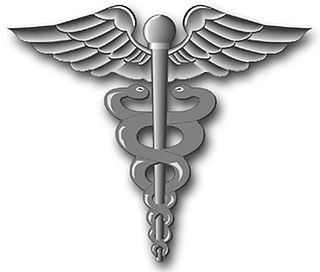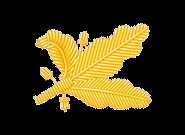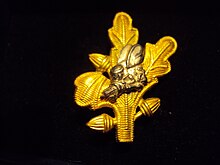In the United States Navy, officers have various ranks. Equivalency between services is by pay grade. United States Navy commissioned officer ranks have two distinct sets of rank insignia: On dress uniform a series of stripes similar to Commonwealth naval ranks are worn; on service khaki, working uniforms, and special uniform situations, the rank insignia are identical to the equivalent rank in the US Marine Corps.
The chart below shows the current enlisted rank insignia of the United States Army, with seniority, and pay grade, increasing from right to left. The enlisted ranks of corporal (E-4) and higher are considered non-commissioned officers (NCOs). The rank of specialist is also in pay grade E-4, but does not hold non-commissioned officer status; it is common that a soldier may never hold the rank of corporal, and instead be promoted from specialist to sergeant, attaining junior NCO status at that time.
The Submarine Warfare Insignia are worn by qualified submariners.
The Fleet Marine Force Warfare Insignia, also known as the Fleet Marine Force badge or FMF pin, are three military badges of the United States Navy which are issued to those U.S. Navy officers and sailors who are trained and qualified to perform duties in support of the United States Marine Corps. There are currently three classes of the Fleet Marine Force pin, being that of enlisted, officer, and chaplain.

The surface warfare insignia is a military badge of the United States Navy which is issued to U.S. Navy personnel who are trained and qualified to perform duties aboard United States surface warships. There are presently four classes of the surface warfare pin, being that of line, staff, special operations, and enlisted. The line and enlisted surface warfare badges may be earned by United States Coast Guard personnel assigned to Navy commands. The various badge types are as follows:
The Naval Aviation Supply Corps insignia is a military badge of the United States Navy which is awarded to Naval Aviation Supply Officers (NASOs) of the Navy Supply Corps who have qualified for duties as a Supply Officer in support of naval aviation and are also qualified to serve in duty assignments onboard aircraft carriers. The Aviation Supply Corps insignia is one of four warfare badges issued to Supply Corps officers by the U.S. Navy. The others are the Navy Expeditionary Supply Corps Officer Badge, Surface Warfare Supply Badge, and the Submarine Supply Corps Badge.

Insignias and badges of the United States Navy are military badges issued by the United States Department of the Navy to naval service members who achieve certain qualifications and accomplishments while serving on both active and reserve duty in the United States Navy. Most naval aviation insignia are also permitted for wear on uniforms of the United States Marine Corps.
In the United States Armed Forces, a line officer or officer of the line is a U.S. Navy or U.S. Marine Corps commissioned officer or warrant officer who exercises general command authority and is eligible for operational command positions, as opposed to officers who normally exercise command authority only within a Navy Staff Corps. The term line officer is also used by the U.S. Air Force and U.S. Coast Guard to indicate that an officer is eligible for command of operational, viz., tactical or combat units. The term is not generally used by officers of the U.S. Army – the roughly corresponding Army terms are basic branch and special branch qualified officers, although the concepts are not entirely synonymous, as some Army special branch officers are eligible to hold command outside their branch specialty.

A hospital corpsman is an enlisted medical specialist of the United States Navy, who may also serve in a U.S. Marine Corps unit. The corresponding rating within the United States Coast Guard is health services technician (HS).

The Command at Sea insignia is a badge of the United States' seagoing services worn by officers on their uniforms to denote that they are the commander, or formerly a commander, of a warship. If the wearer is currently the commander of a warship, it is worn above the nametag, which is worn a quarter of an inch above the right chest pocket on a uniform shirt. Afterwards, the pin is moved to the left side of the shirt or jacket. For the commanders of land-based installations, a different but similar version known as the Command Ashore insignia instead.

The uniforms of the United States Navy include dress uniforms, daily service uniforms, working uniforms, and uniforms for special situations, which have varied throughout the history of the navy. For simplicity in this article, officers refers to both commissioned officers and warrant officers.
In the United States Navy, commissioned officers are either line officers or staff corps officers. Staff corps officers are specialists in career fields that are professions unto themselves, such as physicians, lawyers, civil engineers, chaplains, and supply specialists. For example, a physician can advance to become the commanding officer (CO) of a hospital, the medical hospital on a hospital ship or large warship, or a medical school; or the Chief of the Medical Corps or of the Bureau of Medicine and Surgery. A supply officer can become the CO of a supply depot or a school, or the head of the Naval Supply Systems Command, etc.

The Civil Engineer Corps (CEC) is a staff corps of the United States Navy. CEC officers are professional engineers and architects, acquisitions specialists, and Seabee Combat Warfare Officers who qualify within Seabee units. They are responsible for executing and managing the planning, design, acquisition, construction, operation, and maintenance of the Navy's shore facilities. The Civil Engineer Corps is under the command of the Chief of Civil Engineers and Commander, Naval Facilities Engineering Systems Command. On 12 August 2022, RADM Dean VanderLey relieved RADM John W. Korka, becoming the 46th commander of NAVFAC and Chief of Civil Engineers.

The Naval Supply Systems Command (NAVSUP) serves as the supply command for the United States Navy for providing supplies, services, and support to both the Navy and the United States Marine Corps.

The United States Navy (USN) is the maritime service branch of the United States Armed Forces and one of the eight uniformed services of the United States. It is the largest and most powerful navy in the world, with the estimated tonnage of its active battle fleet alone exceeding the next 13 navies combined, including 11 allies or partner nations of the U.S. as of 2009. It has the highest combined battle fleet tonnage and the world's largest aircraft carrier fleet, with 12 in service, two new carriers under construction, and five other carriers planned. With 336,978 personnel on active duty and 101,583 in the Ready Reserve, the U.S. Navy is the third largest of the United States military service branches in terms of personnel. It has 299 deployable combat vessels and about 4,012 operational aircraft as of July 18, 2023.

The logistics specialist (LS) is a US Navy enlisted rating that was created on 1 October, 2009 by the merger of the storekeeper (SK) and postal clerk (PC) ratings. It also included the previous functions of the former aviation storekeeper (AK) rating, which was previously merged into the former storekeeper (SK) rating on 1 January 2003.
The systems commands, abbreviated as SysCom or SYSCOM, are the materiel agencies of the United States Department of the Navy, responsible for the design, construction, and maintenance of military systems such as ships, aircraft, facilities, and weapons. The systems commands replaced the Navy bureau system in 1966 and report to the Assistant Secretary of the Navy for Research, Development and Acquisition. The current Navy systems commands are:

In the United States Navy, United States Coast Guard, United States Public Health Service Commissioned Corps (USPHS), and National Oceanic and Atmospheric Administration Commissioned Officer Corps, captain is the senior-most commissioned officer rank below that of flag officer. The equivalent rank is colonel in the United States Army, Air Force, Space Force, and Marine Corps.

The Assistant Secretary of the Navy (Research, Development and Acquisition) (abbreviated ASN (RDA)) is a civilian office of the United States Department of the Navy. The Assistant Secretary of the Navy (Research, Development and Acquisition) requires Senate confirmation, and engages in duties as directed by the United States Secretary of the Navy.
The Enlisted Information Warfare Specialist Insignia (EIWS) is a military badge of the United States Navy which was created in 2010. The insignia recognizes those members of the Navy's enlisted force who have acquired the specific professional skills, knowledge, and military experience that result in qualification for service in the information warfare activities of the Navy.















